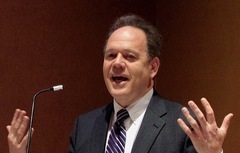Stanley “Skip†Pruss, the director of the Michigan Department of Energy, Labor, and Economic Growth and a nationally regarded clean energy leader, was in Traverse City last week. 
The visit came the day after EPA Administrator Lisa Jackson announced that the federal government would use the Clean Water Act to tame the rapacious mining practices in the Appalachian coal belt involving removing the tops of mountains. Jackson is proposing to lower limits on salinity in mountain streams to level that could make it economically impractical to tear the tops of mountains away. Pruss visit also came just a few days before a coal mine exploded in West Virginia, killing 25 men, and illustrating once again the enormous human consequences of fueling America’s need with million-year-old carbon.
Here in Michigan, the transition to a clean energy economy makes sense on too many levels to adequately describe here. Let’s just say that the market and resource foundations of the drive through economy that Michigan invented in the 20th century aren’t working well in the 21st. Pruss, who is one of Michigan Governor Jennifer Granholm’s closest advisors — he served in the Attorney General’s office with her — was charged by the governor to jump start Michigan’s new economic era. He’s done well. Michigan put in place a modest renewable portfolio standard — 10 percent by 2015 — and has recruited a number of new clean energy manufacturers to join those already based here.
One of the projects that Pruss supports now is Traverse City Light & Power’s plan to acquire 30 percent of its energy from local renewable sources by 2020, a goal that citizens and the utility’s customers have consistently said they support. Full disclosure: I’ve spent several hours a week since January as a communications and engagement strategist for a local utility that proposes to generate 30 percent of its power with local renewable resources by 2020.
One aspect of the plan – a proposal to build a state-of-the-art combined heat and power wood biomass gasification plant – has generated some public concern. At issue are the plant’s emissions (they are much lower than a coal-fired utility), management of ash (it is non-toxic and can be used to add tilth to farm fields), and the sustainability of the fuel supply (multiple studies have shown there is plenty of wood in Michigan and the utility has committed to a sustainable forestry plan.) Other aspects of the wood biomass proposal is that the combined heat and power design doubles the plant’s efficiency, and the 10 mw size is right-scaled and locally operated in a community that is moving to local foods, regional land use and transportation plans, and generating more of what people need right here.
Pruss met for nearly two hours on April 2 in a public meeting with TCL&P’s board included and had this to say about the 30BY20 renewable energy plan and the wood biomass proposal:
On the 30BY20 Plan
Pruss: “For a long time I, as well as many others, have looked at Traverse City Light and Power as being very progressive not only in substance but in process — in engaging the community and asking the public, what are your preferences? How do you think we should chart out the energy future for this city and the region? That is absolutely commendable. And the fact that you are tryng to achieve 30 percent of your power by 2020 is commendable. At a personal level, it complements all the assets and progressive trends that this region represents.â€
On Wood Biomass
Pruss: “I have a little bit of concern about biomass. They relate to sustainable supply. But this proposal by Traverse City Light and Power is cogeneration. And cogeneration is an absolutely essential trend. It’s state of the art. It’s cutting edge. And what it does is essentially double the energy efficiency of the power plant. Which is what you want to do. A biomass plant that is a combined heat and power plant is a tremendous asset. If this community were to do that, if TCL&P were to do that, it would be a precedent-setting achievement that we would commend other utilities to emulate. That is real leadership.â€
Should TCL&P Delay Its Decision?
Pruss: “Not everyone can wait on the sidelines. You have to make the most prudent and economical judgments that you can. Your plant positions you well for the future. It really does. Grand Rapids. Ann Arbor. They are where you’re at and are regarded not just by other communities around the state but nationally as having the foresight to do this in a thoughtful, deliberate, and economical way. You are all to be commended.â€
Michigan’s Forests and Sustainable Fuel Supply
Pruss: “Michigan has huge forest resources. We have waste wood resources. We have a lot of available biomass. We also have great capacity within our research universities, MSU and Michigan Tech in particular. They have been working to understand and calculate and model out wood availability, and also solve the logistical problems of delivery.
Here is my concern with biomass, not that we don’t have the supply and not that we can’t harvest that supply and deliver it in a sustainable way. We can. The concern is that we have a lot of potential biomass fuel projects both for combustion and biofuels, more of the former than the latter. But there are new projects that pop up. If they do advance they would be competing for the same supply. We don’t know a whole lot about price sensitivity except there is price sensitivity at some point in time.
I’m aware of 192 megawatts of projects proposed for the northern part of the Lower Peninsula. I would bet money that not all of those projects are going to proceed. They will not. The point is that other projects will pop up on the horizon and advance. What government can do and should do, and what we are doing — we’re building the capacity with our universities. We have consultants doing this. We are spending a lot of money to say this is how much biomass we have. This is our best calculation. This is how much there is. So you can plan and know how much is out there on a sustainable basis.
With respect to your plan – because it involves cogeneration which doubles the efficiency of the plant – that is hugely important. I know Governor Granholm and I would like that plant to proceed. â€
Benefits and Burdens of Clean Energy
Pruss: “With wind, with solar, with biomass there are benefits and burdens. There are no perfect solutions. I like to quote Bill McKibben, an energy expert at Middlebury College in Vermont. There are no silver bullets but there is silver buckshot.
Your plant, I’m guessing, is 70 to 80 percent efficient. That is huge. That means you’re going to be twice as energy efficient as anything out there. I think that so important. That is part of the calculus in the equation of benefits and burden. The fact that your plant is going to be so energy efficient is great. I want you to be an example for other communities around the state.â€
Should Community Lay Its Bet on Biomass or Take it Slower?
Pruss: – “TCL&P and the community have been working on this for awhile. I am an observer from a distance. In preparation for this meeting I read the IRP (Integrated Resource Plan). I looked at some other materials. I looked at the proposal by the Michigan Land Use Institute. I don’t have the depth or background to pass judgment. I don’t have the benefit of the interaction this board has had with their consultants. It would be presumptuous of me to say ‘do it this way or do it that way.’
There are choices to be made. I would be disinclined to wait a year or two before you act. I think you should be aggressive. If you are really on a pathway to generate 30 percent of your energy from renewable resources it’s going to be that much easier to establish a new goal when you get there, because you are going to be that much farther ahead.â€
— Keith Schneider

